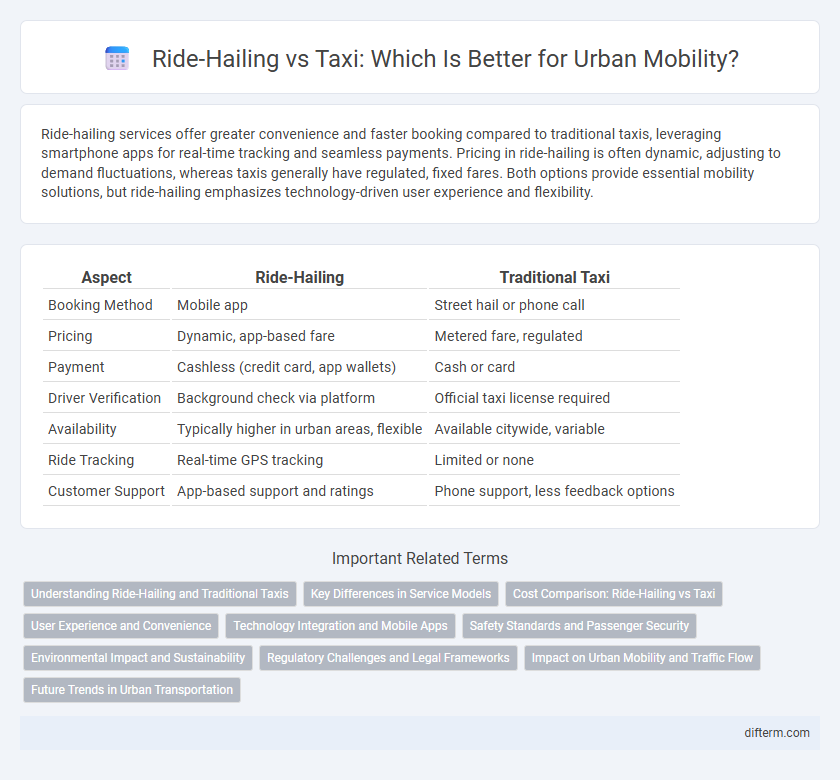Ride-hailing services offer greater convenience and faster booking compared to traditional taxis, leveraging smartphone apps for real-time tracking and seamless payments. Pricing in ride-hailing is often dynamic, adjusting to demand fluctuations, whereas taxis generally have regulated, fixed fares. Both options provide essential mobility solutions, but ride-hailing emphasizes technology-driven user experience and flexibility.
Table of Comparison
| Aspect | Ride-Hailing | Traditional Taxi |
|---|---|---|
| Booking Method | Mobile app | Street hail or phone call |
| Pricing | Dynamic, app-based fare | Metered fare, regulated |
| Payment | Cashless (credit card, app wallets) | Cash or card |
| Driver Verification | Background check via platform | Official taxi license required |
| Availability | Typically higher in urban areas, flexible | Available citywide, variable |
| Ride Tracking | Real-time GPS tracking | Limited or none |
| Customer Support | App-based support and ratings | Phone support, less feedback options |
Understanding Ride-Hailing and Traditional Taxis
Ride-hailing services utilize smartphone apps to connect passengers with nearby drivers, offering convenience through real-time tracking, cashless payments, and flexible vehicle options. Traditional taxis operate via street hails or dispatch services, typically regulated by local authorities with fixed fare structures and strict licensing requirements. The ride-hailing model emphasizes technology-driven efficiency, while taxis focus on established regulatory compliance and standardized service protocols.
Key Differences in Service Models
Ride-hailing services operate through app-based platforms, enabling users to book rides conveniently and track drivers in real-time, while traditional taxis rely on street hails or phone dispatch. Pricing in ride-hailing is typically dynamic, adjusting based on demand, whereas taxi fares follow fixed or regulated rates. The vehicle fleet in ride-hailing is usually privately owned by drivers, contrasting with licensed taxi fleets subject to local regulations and medallion systems.
Cost Comparison: Ride-Hailing vs Taxi
Ride-hailing services generally offer lower base fares and dynamic pricing models that can reduce costs during off-peak hours compared to traditional taxis, which often have fixed rates regulated by local authorities. Surge pricing in ride-hailing apps may cause fares to exceed taxi costs during high demand, but discounts and promotions often balance the overall expenditure. Taxi fares typically include additional fees such as airport surcharges and waiting time charges, which are frequently transparent and less variable than the dynamic pricing seen in ride-hailing platforms.
User Experience and Convenience
Ride-hailing services offer seamless app-based booking, real-time tracking, and transparent fare estimates, enhancing user experience over traditional taxis. Passengers benefit from cashless payments, personalized ride options, and shorter wait times due to efficient driver allocation algorithms. In contrast, taxis often require street hailing or phone calls and may lack digital conveniences, impacting overall convenience and user satisfaction.
Technology Integration and Mobile Apps
Ride-hailing services leverage advanced GPS technology and seamless mobile app interfaces to provide real-time ride tracking, upfront pricing, and cashless payments, enhancing user convenience compared to traditional taxi systems. Taxi companies are increasingly adopting mobile apps to offer digital booking, in-app payments, and driver ratings, narrowing the gap with ride-hailing platforms. Integration of AI algorithms in ride-hailing apps optimizes route selection and dynamic pricing, driving efficiency that traditional taxi dispatch systems often lack.
Safety Standards and Passenger Security
Ride-hailing services implement advanced GPS tracking and real-time driver verification to enhance passenger security, often surpassing traditional taxi safety protocols. Many ride-hailing platforms mandate thorough background checks and continuous monitoring, while conventional taxis may rely on localized regulations that vary widely. Enhanced digital reporting tools and in-app emergency features contribute to quicker response times in ride-hailing, improving overall safety standards for passengers.
Environmental Impact and Sustainability
Ride-hailing services typically generate lower carbon emissions per trip compared to traditional taxis by optimizing route efficiency and utilizing app-based ride pooling options. Electric and hybrid vehicles are increasingly integrated into ride-hailing fleets, further reducing their environmental footprint and promoting sustainable urban mobility. Taxi services, although evolving, often rely on older vehicle models with higher emissions, making ride-hailing a more eco-friendly choice for reducing air pollution and traffic congestion.
Regulatory Challenges and Legal Frameworks
Ride-hailing services face complex regulatory challenges as they operate in a legal gray area distinct from traditional taxi regulations, leading to conflicts over licensing, insurance, and safety standards. Governments worldwide are struggling to update legal frameworks to address issues such as driver employment status, fare transparency, and passenger data privacy while ensuring fair competition with established taxi industries. The evolving legal landscape demands adaptive policies that balance innovation with public interest and equitable market conditions.
Impact on Urban Mobility and Traffic Flow
Ride-hailing services contribute to increased traffic congestion in urban areas by encouraging more vehicle trips compared to traditional taxis, which typically have higher occupancy rates and more regulated fleet sizes. Studies reveal that ride-hailing often leads to longer vehicle miles traveled (VMT) and increased deadheading, negatively impacting traffic flow and exacerbating peak-hour gridlock. Urban mobility is further strained as ride-hailing vehicles compete for curb space and parking, reducing overall roadway efficiency and increasing travel times.
Future Trends in Urban Transportation
Ride-hailing services leverage real-time data analytics and AI to optimize route efficiency, reducing urban congestion compared to traditional taxis constrained by fixed fares and limited digital integration. The rise of electric and autonomous vehicles within ride-hailing fleets accelerates the shift toward sustainable urban mobility solutions. Smart city infrastructure increasingly supports seamless integration between ride-hailing platforms and public transit, enhancing last-mile connectivity and reducing overall carbon emissions.
ride-hailing vs taxi Infographic

 difterm.com
difterm.com